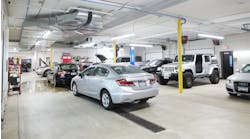Measuring an independent shop has now changed in so many ways if the owner is looking for a proper return on the investment made. Just as the vehicle has changed in the past 10 years, so too has the analysis of the shop business.
When the business is measured correctly and analyzed properly, it will define every problem the shop has and therefore a definitive plan to correct the problem(s) can be made. I always have taught my clients and students to “do the math – and follow the math because the math does not lie.” Too many owners run their business with their emotional bank account and end up regretting their decisions later on not to mention the lost net income due to their emotional decisions.
Consider these six basic shop objectives and compare them to your own operation.
1). The shop should now be billing a minimum of $1.25 in labor to every $1 in total parts sold. Labor billed is made up of maintenance labor, diagnostic and re-flash labor. Parts are aftermarket parts and dealer parts only. It does not include oil/fluids, tires or batteries.
2). Diagnostic labour billed should be an additional 10 percent minimum of maintenance labour billed. For example if the shop billed $40,000 in maintenance labour for the month, there should also be a minimum of an additional $4,000 in diagnostic billed labour for a total labour billed of $44,000 for the month.
3). The shop should be billing an average of 2.5 billed hours per Repair Order for basic consumer vehicle maintenance work, an average of 4 to 6 billed hours per RO for 1 ton/cube van mid duty type work, and 10 to 12 hours average for heavy duty type work.
4). The shop should be billing a minimum of $1.20 in labor (as defined in No. 1 above) for every $1 it pays out in the entire wage/payroll package of the shop. The wage/payroll package of the shop includes all owner/management, technician, helper, service advisor and administration wages paid in the shop as well as all wage burden paid by the shop which includes all staff benefits, workers compensation and the shops additional payroll taxes legislated by state and federal government.
5) The shop should have a minimum of three labor rates today, namely, a maintenance labor rate, a diagnostic labour rate and a re-flash labor rate. The better shops are up to five rates today including a tire install rate and a fluid installation rate. All rates are set to the consumer based on the competency of the individual performing the work.
6) The shop should be averaging a minimum of 75 percent “site” efficiency. Don’t confuse this with proficiency. Site efficiency is the measurement of the team working together compared to the individual measurement with proficiency.
These are the very basic measurement objectives that should be performed weekly and monthly by management and all technicians and service advisors should be trained as to their importance and what it means to them, the shop and to the consumer.
Consider the changing business model entering the aftermarket this year. We came from a break down and repair world 40 years ago to a preventative maintenance world eight years ago, and now we witness the introduction of the service on need world in 2013 thanks to the introduction of aftermarket telematics. Technology changes our industry and we must always re-learn to adapt.
The business model has and is changing and therefore the measurement of the shop must change as well. It no longer is about total sales in a shop, it is all about billed hours in a shop. Do the math.
Stop attending courses that promote sales and activity and being busy all the time by trying to get you to be the most competitive lowest price in the market. A shop does not want to be busy; it wants to be steady. There are only three ways to run a shop business: price, service and quality --- pick two. A professional independent shop is not the cheapest priced business; it is in the knowledge business and therefore focuses in on service and quality by hiring, training and retaining competent staff.
When the consumer hires the shop to professionally inspect the vehicle for “safety and reliability” and proper estimates are presented for counseling the consumer about their vehicle based on how they use it and their expectations with it, billed hours are created. When billed hours are sold with preventative maintenance or repairs, commodities are sold also. Too many companies in the aftermarket have taught, in essence, “sell some parts and you might get some labor.” Today, when a shop sells its knowledge (labour), in most cases parts just follow along with it. Commodity sales alone will not save a business however the right billed hours in a business will provide a proper bottom line, income security and a fine life for all connected with the shop. The math says in order to create and build net profit the independent shop cannot discount itself into prosperity. Do the math. I can assure you of one thing in this industry — no one, absolutely no one, will prevent you from going bankrupt.
The above paragraphs are just the tip of the iceberg in shop management today. Today’s professional shop owners and managers realize they must take the time and learn to build a TAP. This is a full culture shift in the Independent business.
“T” stands for team. No longer can a shop owner do it all him or herself. Management must hire competency, not just a body. A knowledgeable team must be built and this is becoming more prevalent than ever before as the diagnostic world continues to grow. The shop talent will be diversified with various skill levels within the depth of staff hired.
A stand for accountability. Too many owners/managers do not hold their team accountable out of fear they may quit so they end up as baby sitters for the staff. This is unacceptable and unprofessional. Great employees want accountability because accountability will prove how well they will shine. It is when management let’s weaker employees get away with things that others can not that great employees keep looking for the right business to join.
P is for perseverance. Changing a culture of a business or company does not happen in 30 days, 6 months or one year. On average, expect three to five years to get this done and it will first start with the owner/manager, not the employees. If the team cannot see and witness through their actions management moving to a different level of thinking and acting, the team will not follow. Management must lead through example. Walk the talk. This culture change is not something you buy into; it must be something that you believe in.
I will end with this thought:
“Are you building a Career oriented shop or a Job oriented shop?” A Career is an environment where you go and feel you can use your talents, and those talents are appreciated. A Job is an environment where you go each day and degrade yourself for a paycheck.
The choice is yours. Welcome to the new aftermarket.
Subscribe to Motor Age and receive articles like this every month…absolutely free. Click here



